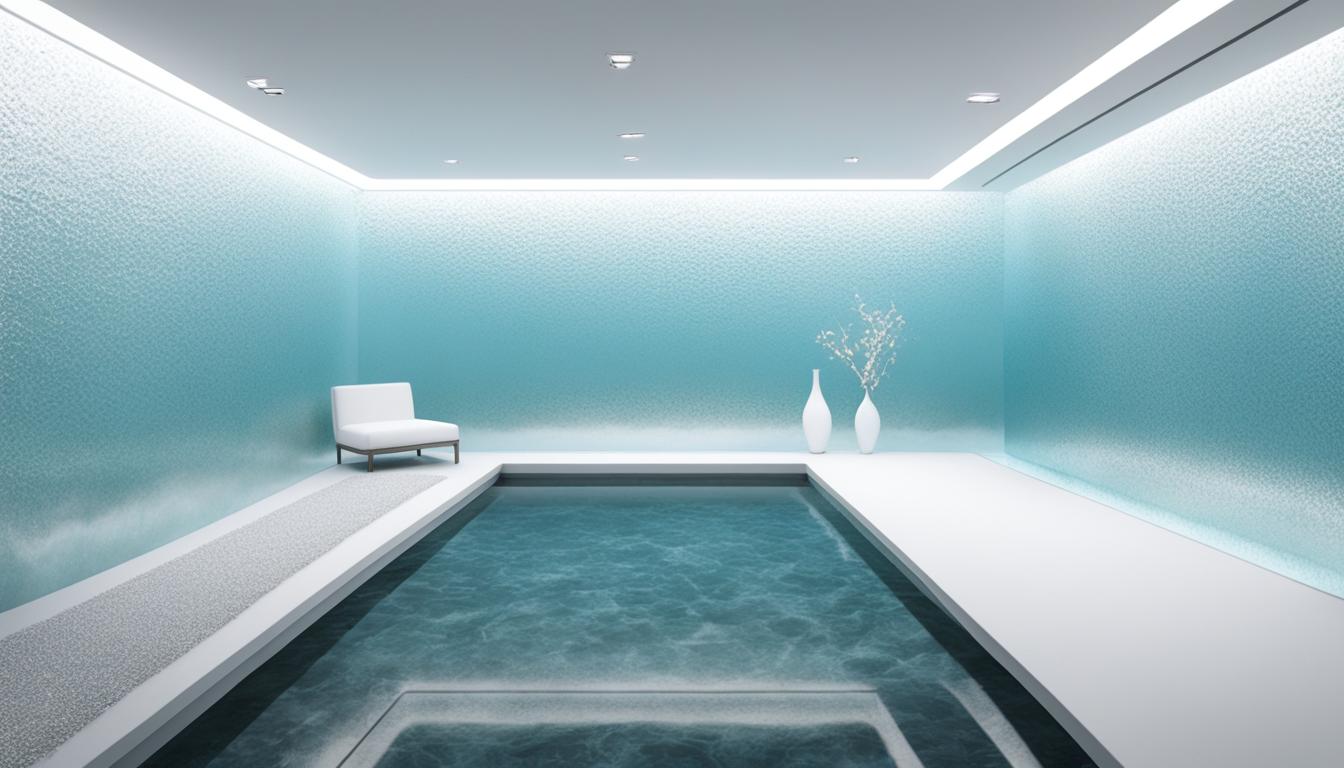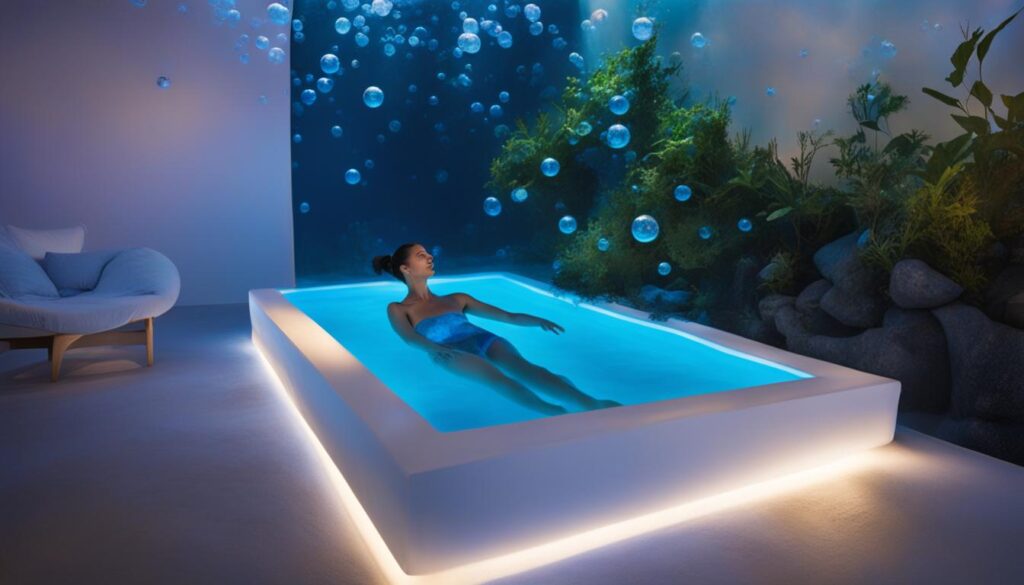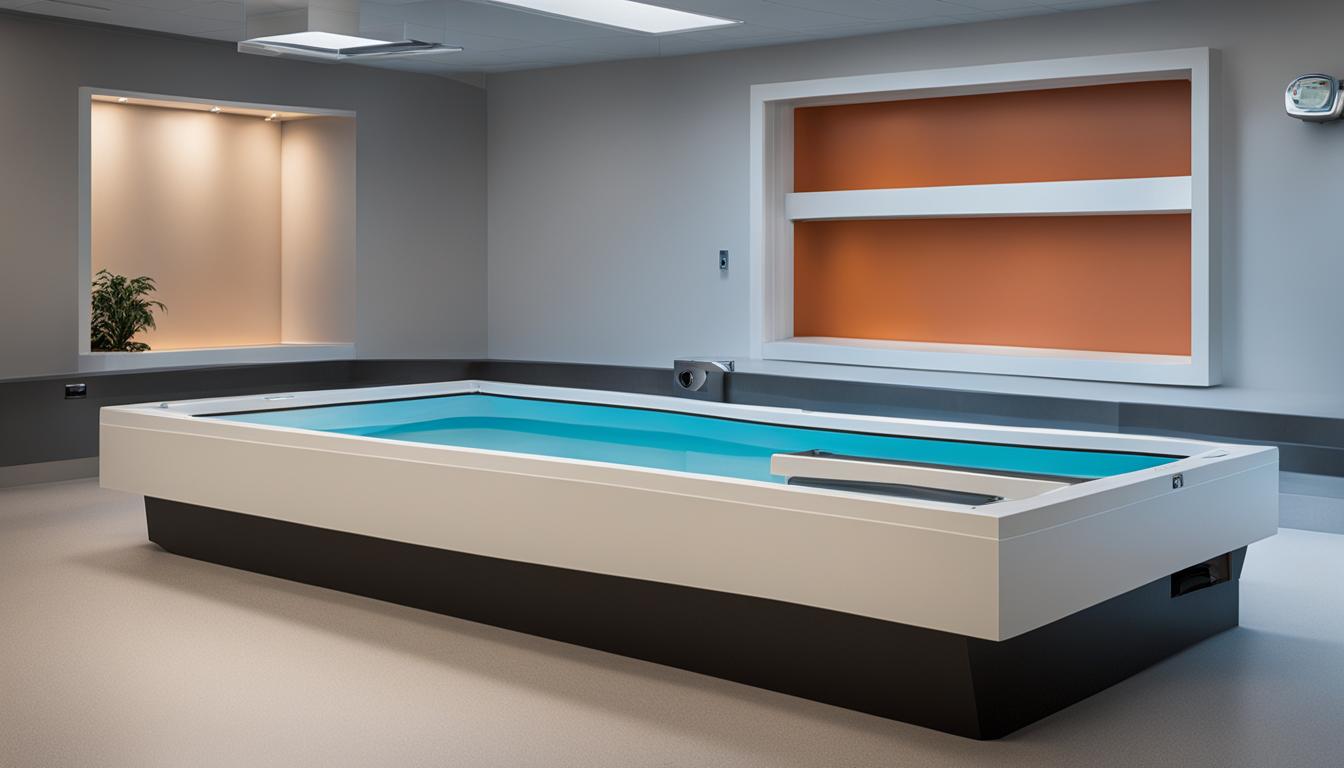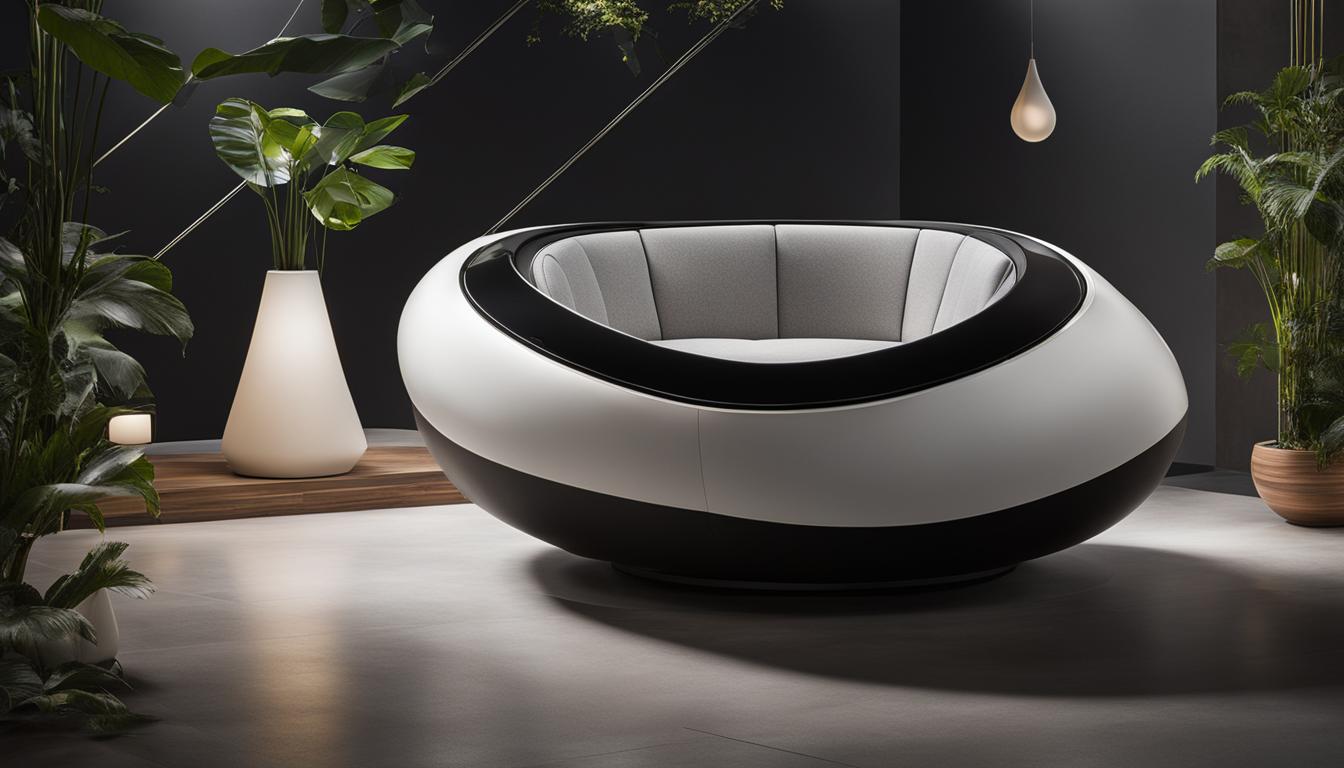When it comes to achieving relaxation and reducing stress levels, float tanks have gained immense popularity. These sensory deprivation tanks provide a unique experience that allows individuals to detach themselves from external distractions and focus on mindfulness.
In this article, I will explore the different types of float tanks available and explain the characteristics of each one. Whether you’re a beginner or an experienced floater, understanding the various options will help you choose the best type of float tank for your needs.
Types of Float Pods
Float pods are a popular type of sensory deprivation tank that provides a relaxing and rejuvenating experience. These state-of-the-art relaxation pods offer a unique environment for individuals to unwind and find tranquility.
Float pods are designed with user comfort and relaxation in mind. Here are some key features of float pods:
- Size: Float pods are typically 7 feet in length and 4 feet in width. This spacious interior allows users to stretch out and fully relax during their floatation experience.
- Domed Lid: The domed lid design ensures that users have a non-claustrophobic experience. The gentle curve of the lid creates an airy and open feeling, allowing users to feel at ease throughout their float therapy session.
- Back Opening: Float pods have a back opening for air circulation, which helps maintain a comfortable environment inside the pod. This feature also allows for easy entry and exit, ensuring a hassle-free experience.
With their spacious interior, domed lid design, and back opening, float pods provide a soothing and calming sensory deprivation experience. They are widely recognized for their ability to promote relaxation, alleviate stress, and enhance overall well-being.
Cabin Style Float Tanks
When it comes to float tanks, cabin-style tanks offer a unique and immersive experience. These tanks are larger than standard float pods, providing a spacious and voluminous area for users to move around freely. Unlike pods where users usually lie down, cabin-style tanks allow you to stand upright, enhancing the sense of freedom and relaxation.
One of the advantages of cabin-style float tanks is the ability to move around effortlessly, making it suitable for those who may feel claustrophobic in enclosed spaces. The expansive interior provides a more open and spacious feeling, allowing you to fully stretch out and enjoy the floating experience.
Moreover, cabin-style tanks often come equipped with additional features such as adjustable lighting and audio systems. These features allow you to create a personalized floating experience by setting the lighting and playing soothing music or guided meditations.
Whether you are a seasoned floater or a first-timer, cabin-style float tanks offer a unique opportunity to fully immerse yourself in relaxation and sensory deprivation. The combination of the spacious interior, standing capability, and customizable ambiance makes cabin-style tanks a popular choice among float enthusiasts.
If you prefer a more immersive and expansive floating experience, cabin-style tanks are definitely worth exploring. The next section will delve into another type of float tank that provides a different approach to sensory deprivation and relaxation.
Open Float Rooms
Open float rooms offer a unique and liberating experience for those seeking relaxation and sensory deprivation. Unlike enclosed float tanks, open float rooms provide a spacious environment, allowing users to fully immerse themselves without feeling confined. These rooms are specifically designed to regulate sound and light, creating a serene atmosphere ideal for relaxation and tranquility.
The open float room concept is especially beneficial for individuals with claustrophobia or disabilities who may feel discomfort in enclosed spaces. The sense of openness and freedom provided by open float rooms allows for a more comfortable and enjoyable floating experience.
For those who prefer a customizable floating experience, open float rooms offer a range of options to enhance relaxation. Users have the freedom to adjust the lighting according to their preference, creating a soothing ambiance that promotes deep relaxation. Additionally, the sound within these rooms can also be controlled, ensuring a peaceful and uninterrupted floatation experience.

“Open float rooms provide a sense of spaciousness and freedom, allowing me to fully let go and immerse myself in relaxation.”
Whether you are a first-time floater or a seasoned enthusiast, open float rooms offer a versatile and comfortable space to experience the many benefits of floatation therapy. The sense of openness and freedom they provide can enhance the overall relaxation and mindfulness experience, enabling you to achieve a state of deep tranquility.
Key Features of Open Float Rooms:
- Spacious environment for a more comfortable and unrestricted floating experience
- Regulated sound and light settings to create a serene and relaxing atmosphere
- Customizable options, such as adjustable lighting and sound, to enhance relaxation
- Ideal for individuals with claustrophobia or disabilities who may prefer an open and liberating space
Benefits of Floating Therapy
Floating therapy, also known as sensory deprivation therapy, offers a wide range of benefits for both the mind and body. Let’s explore the numerous advantages of this innovative relaxation technique:
- Reduced Inflammation: By immersing yourself in a float tank, you can experience a decrease in inflammation throughout your body. This can be particularly beneficial for individuals with chronic inflammatory conditions.
- Muscle Tension Relief: The weightlessness and buoyancy of floating in a sensory deprivation tank help relieve muscle tension and promote relaxation. It allows your muscles to fully relax and recover from everyday stress and strain.
- Stress Reduction: Floating therapy is known for its ability to reduce stress levels. By eliminating external stimuli and providing a serene environment, floating helps calm the mind and release tension, leading to a profound sense of relaxation.
- Improved Sleep Quality: Regular float therapy sessions can result in improved sleep quality. The deep relaxation experienced during floating can help regulate sleep patterns, leading to more restful and rejuvenating sleep.
- Enhanced Creativity: Many individuals report an increase in creativity and problem-solving abilities after floating. By disconnecting from the outside world and giving your mind space to wander, floating therapy can stimulate fresh ideas and enhance creative thinking.
- Increased Physical Health: Floating therapy can have a positive impact on physical health. It helps improve circulation, lowers blood pressure, and supports overall cardiovascular health. Additionally, the weightless environment can provide relief for joint and muscle pain.
Overall, floating therapy offers a holistic approach to relaxation and mindfulness. It combines the benefits of stress relief, improved sleep quality, enhanced creativity, and increased physical health into one transformative experience.
| Benefit | Description |
|---|---|
| Reduced Inflammation | By immersing yourself in a float tank, you can experience a decrease in inflammation throughout your body. This can be particularly beneficial for individuals with chronic inflammatory conditions. |
| Muscle Tension Relief | The weightlessness and buoyancy of floating in a sensory deprivation tank help relieve muscle tension and promote relaxation. It allows your muscles to fully relax and recover from everyday stress and strain. |
| Stress Reduction | Floating therapy is known for its ability to reduce stress levels. By eliminating external stimuli and providing a serene environment, floating helps calm the mind and release tension, leading to a profound sense of relaxation. |
| Improved Sleep Quality | Regular float therapy sessions can result in improved sleep quality. The deep relaxation experienced during floating can help regulate sleep patterns, leading to more restful and rejuvenating sleep. |
| Enhanced Creativity | Many individuals report an increase in creativity and problem-solving abilities after floating. By disconnecting from the outside world and giving your mind space to wander, floating therapy can stimulate fresh ideas and enhance creative thinking. |
| Increased Physical Health | Floating therapy can have a positive impact on physical health. It helps improve circulation, lowers blood pressure, and supports overall cardiovascular health. Additionally, the weightless environment can provide relief for joint and muscle pain. |
How Float Therapy Works
Float therapy, also known as sensory deprivation therapy, is a unique and effective method for achieving deep relaxation and mindfulness. This process involves immersing oneself in a water-filled sensory deprivation tank, which is specifically designed to minimize external stimuli. By depriving the senses of light, sound, and temperature fluctuations, float therapy aims to create a calm and serene environment that promotes a state of deep relaxation and mental clarity.
During a float therapy session, individuals enter a specially designed tank filled with warm water and Epsom salts, creating a buoyant environment that allows them to effortlessly float on the surface. The water is typically kept at skin temperature, which helps to eliminate any sensations of hot or cold, ensuring maximum comfort throughout the session.
The sensory deprivation tank is enclosed, providing a serene and private space. Its design effectively reduces external distractions, allowing individuals to turn their attention inward and focus on their internal experiences. The goal of float therapy is to create a state of sensory isolation, enabling participants to detach from the outside world and fully immerse themselves in a state of relaxation and mindfulness.
“Float therapy is a powerful tool for achieving deep relaxation and introspection. By removing external sensory input, individuals can truly disconnect from the outside world and tap into their inner peace and stillness.”
By eliminating external stimuli, such as light and sound, float therapy promotes a sense of calmness and tranquility. This sensory deprivation allows the mind to quiet down and enter a state of deep relaxation, reminiscent of a meditative experience. The absence of external distractions helps individuals cultivate mindfulness and enhance their ability to focus on the present moment.
Float therapy offers a myriad of benefits, both physical and mental. Many individuals find that regular float therapy sessions can alleviate stress, reduce anxiety, improve sleep quality, and enhance overall well-being. The state of deep relaxation experienced during float therapy can also aid in pain management, muscle recovery, and physical rejuvenation.
If you’re curious about trying float therapy, it’s important to find a reputable spa or wellness center that offers this service. A trained professional will guide you through the process and ensure your safety and comfort throughout the session. Remember, float therapy is a deeply personal experience, and each individual may have a unique response to the process.
Allow yourself to escape the hustle and bustle of everyday life and discover the profound benefits of float therapy. Immerse yourself in the sensory deprivation tank, embrace the silence, and allow yourself to experience the true essence of relaxation and mindfulness.

What to Expect During a Float Therapy Session
When you participate in a float therapy session, you’ll be immersed in a unique sensory deprivation experience. The session typically lasts around one hour, offering you a dedicated time for relaxation and mindfulness practice.
As you prepare for your float therapy session, here’s what you can expect:
- Entering the Water-Filled Tank: Once you arrive at the spa or center, you’ll be directed to the float tank room. The tank is filled with warm water and Epsom salts to create the perfect buoyancy for floating. You’ll enter the tank wearing a swimsuit.
- Wearing Wax Earplugs: To enhance the sensory deprivation experience, wax earplugs will be provided. These earplugs help to reduce sound and create a tranquil environment for relaxation.
- Dimly Lit Environment: The float tank room is usually dimly lit to minimize visual stimuli. This soft lighting helps create a calming and soothing atmosphere, allowing you to let go and fully relax.
- Tank Lid Open or Closed: You have the option to choose whether to keep the tank lid open or closed during your session. Some individuals prefer an open lid for a more spacious experience, while others enjoy the enclosed feeling of a closed lid.
- Floatation Position: Once inside the tank, you’ll find a comfortable floatation position that allows you to effortlessly float on the water’s surface. The high concentration of Epsom salts in the water allows for effortless buoyancy, giving you a sensation of weightlessness.
- Relaxation and Mindfulness: Once you’re settled in the tank, it’s time to relax and practice mindfulness. Let go of any tension, stress, or thoughts that may arise. Focus on your breath and immerse yourself in the present moment, embracing the feeling of weightlessness and serenity.
As you emerge from your float therapy session, take the time to savor the feelings of relaxation and rejuvenation. Many individuals report a deep sense of calmness, reduced stress levels, and enhanced mental clarity after a float therapy session.

Safety Considerations for Float Therapy
Float therapy is a generally safe practice that offers numerous benefits for relaxation and mindfulness. However, it’s important to consider certain factors to ensure a safe and enjoyable experience. Here are some safety considerations to keep in mind:
- If you have claustrophobia, epilepsy, low blood pressure, or open wounds, it’s crucial to consult with your healthcare provider before trying float therapy. They can provide personalized advice based on your specific circumstances.
- It’s essential to maintain proper hygiene to minimize any potential risks. Follow the recommended cleaning protocols for the float tanks to ensure cleanliness and prevent the spread of infections.
By taking these safety precautions, you can enjoy the incredible benefits of float therapy with peace of mind.
| Safety Considerations for Float Therapy: |
|---|
| If you have claustrophobia, epilepsy, low blood pressure, or open wounds, consult with a healthcare provider before trying float therapy. |
| Maintain proper hygiene and follow recommended cleaning protocols for the float tanks. |

The Cost of Float Therapy
When considering float therapy, it’s important to understand the cost involved. The pricing for float therapy sessions can vary based on factors such as location and spa membership. On average, a one-hour session can range from $50 to $100.
It’s worth noting that the cost of float therapy is not typically covered by health insurance. Float therapy is considered a complementary and alternative medicine approach, falling outside the scope of insurance coverage.
While float therapy may require an investment, many individuals find it to be a worthwhile expense for the numerous benefits it offers. Now, let’s take a look at a detailed breakdown of the costs associated with float therapy.
| Type of Session | Duration | Cost Range |
|---|---|---|
| Single Session | 1 hour | $50 – $100 |
| Multiple Session Packages | Varies | Discounted rates available |
| Monthly Memberships | Unlimited sessions | Starting from $150 per month |
As shown in the table above, there are various options available to suit different preferences and budgets. Some float therapy centers offer multiple-session packages with discounted rates, making it more affordable for regular attendees. Additionally, monthly memberships provide unlimited access to float therapy sessions at a fixed monthly fee.
It’s important to consider the value that float therapy brings to your overall well-being and relaxation. Remember, investing in self-care and mindfulness practices can have long-lasting benefits for both your physical and mental health.
Testimonials
“The cost of float therapy is well worth it considering the incredible relaxation and stress relief I experience during each session. It’s become an essential part of my self-care routine.” – Sarah, Washington
As Sarah from Washington mentioned, the cost of float therapy is often outweighed by the positive impact it has on individuals’ well-being. It offers a unique and effective way to achieve relaxation and mindfulness, making it a valuable investment for many.
Conclusion
In conclusion, float therapy offers a unique and effective way to achieve relaxation and mindfulness. With different types of float tanks available, individuals can find the one that suits their needs and preferences. Whether it’s a float pod, cabin-style tank, or open float room, each option provides a tranquil environment for rejuvenation.
Floating therapy has a wide range of benefits that contribute to overall well-being. It helps reduce stress levels, improve sleep quality, enhance creativity, and increase focus. By immersing oneself in the sensory deprivation experience, individuals can escape the pressures of daily life and find inner peace.
Through the sensory deprivation process, float therapy promotes deep relaxation and mindfulness. By depriving the senses of external stimuli, such as light, sound, and temperature fluctuations, it allows the mind to quiet down and achieve a state of serenity. This practice serves as a holistic approach to achieving physical and mental well-being.
In summary, float therapy is a powerful tool for self-care and self-discovery. It offers a sanctuary where individuals can escape the noise of the world and reconnect with themselves. Whether seeking stress relief, improved sleep, enhanced creativity, or simply a moment of tranquility, float therapy provides an oasis of relaxation and rejuvenation.
FAQ
What are the different types of float tanks?
There are three main types of float tanks – float pods, cabin-style float tanks, and open float rooms.
What are float pods?
Float pods are small, dome-shaped tanks that are 7 feet long and 4 feet wide. They have a back opening for air circulation and provide a non-claustrophobic experience.
What are cabin-style float tanks?
Cabin-style float tanks are larger than float pods and offer a more immersive experience. They provide a spacious area for users to move around while standing upright.
What are open float rooms?
Open float rooms are unique in design, eliminating the need for an enclosed space. These rooms provide a customizable floating experience and offer a sense of openness and freedom.
What are the benefits of floating therapy?
Floating therapy offers numerous benefits, including reduced inflammation, muscle tension relief, stress reduction, improved sleep quality, enhanced creativity, and increased physical health.
How does float therapy work?
Float therapy involves floating in a water-filled sensory deprivation tank, which minimizes external stimuli. The goal is to achieve a calm and relaxed state by depriving the senses of light, sound, and temperature fluctuations.
What should I expect during a float therapy session?
During a float therapy session, you will enter a water-filled tank wearing a swimsuit and earplugs. The environment will be dimly lit, and you can choose to keep the tank lid open or closed. The session typically lasts around one hour, allowing you to immerse yourself in relaxation.
Are there any safety considerations for float therapy?
While float therapy is generally safe, individuals with claustrophobia, epilepsy, low blood pressure, or open wounds should consult with a healthcare provider before trying it. It’s also important to maintain proper hygiene and follow the recommended cleaning protocols for the tanks.
How much does float therapy cost?
The cost of a float therapy session can vary depending on the location and spa membership. On average, a one-hour session can range from $50 to $100. It’s important to note that health insurance typically does not cover the cost of float therapy.
Are there any specific types of float tanks that are better than others?
The best type of float tank will depend on individual preferences and needs. Float pods provide a more compact experience, while cabin-style tanks offer a larger, immersive space. Open float rooms are ideal for individuals with claustrophobia or those who prefer a sense of openness.
How does float therapy contribute to relaxation and mindfulness?
Float therapy provides a unique and effective approach to achieving relaxation and mindfulness. By minimizing external stimuli and creating a calm environment, floating therapy helps to quiet the mind, induce deep relaxation, and promote a sense of well-being.

